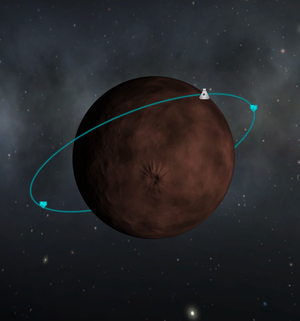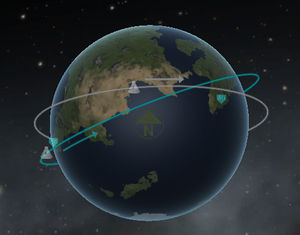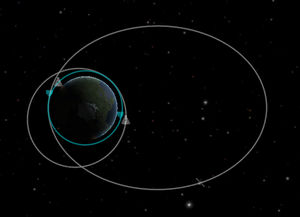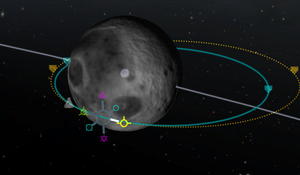Difference between revisions of "User:Kerbin Dallas Multipass/Orbit"
m (clear right test) |
|||
| Line 7: | Line 7: | ||
{{Main article|Terminology}} | {{Main article|Terminology}} | ||
=== Inclination === | === Inclination === | ||
| − | + | ||
[[File:Kerbalinclinedorbit.jpg|thumb|With an inclination of 20° these two crafts orbit planet Kerbin]] | [[File:Kerbalinclinedorbit.jpg|thumb|With an inclination of 20° these two crafts orbit planet Kerbin]] | ||
The angle, by which an orbit is '''inclined''' in relation to another orbit. | The angle, by which an orbit is '''inclined''' in relation to another orbit. | ||
Inclination also used in reference to the equator of a celestial body. | Inclination also used in reference to the equator of a celestial body. | ||
| − | + | {{clear|right}} | |
=== Eccentricity === | === Eccentricity === | ||
| − | + | ||
[[File:KerbalEccentricity.jpg|thumb|Eccentric orbits (white) and a non-eccentric orbit (blue)]] | [[File:KerbalEccentricity.jpg|thumb|Eccentric orbits (white) and a non-eccentric orbit (blue)]] | ||
Lorem ipsum | Lorem ipsum | ||
| − | + | {{clear|right}} | |
=== Pereapsis and apoapsis === | === Pereapsis and apoapsis === | ||
| − | + | ||
[[File:ManeuverNodePrograde.PNG|thumb|Placeholder image]] | [[File:ManeuverNodePrograde.PNG|thumb|Placeholder image]] | ||
Lorem ipsum | Lorem ipsum | ||
| − | + | {{clear|right}} | |
== Types of orbits == | == Types of orbits == | ||
Latest revision as of 00:39, 7 September 2013

An orbit is an elliptical path around a celestial body. The point on an
Contents
Terminology
- → Main article: Terminology
Inclination
The angle, by which an orbit is inclined in relation to another orbit. Inclination also used in reference to the equator of a celestial body.
Eccentricity
Lorem ipsum
Pereapsis and apoapsis
Lorem ipsum
Types of orbits
Low Kerbin orbit (LKO)
In analogy to the real world low Earth orbit (LEO) an LKO describes a stable low orbit around Kerbin that can be achieved with relatively low cost of Delta-V. The lowest point of an LKO must not be lower than 70 km in order to stay clear of atmospheric drag. The altitude of an LKO typically does not exceed about 200 km.
Tons of payload delivered to LKO is often used to compare performance and size of launch vehicles.
In optimal circumstances LKO can be achieved with 4450-4700 m/s Delta-V.[1]
Due to the Oberth effect a low orbit is a suitable starting point for transferring to other celestial bodies. [citation needed]
Stationary orbit and synchronous orbit
- → Main article: Stationary orbit
An orbit with the same orbital period as the rotational period of the orbited body is called a synchronous orbit. If the inclination is also 0° and there is no eccentricity it is called a stationary orbit. A satellite in this orbit doesn't appear to move when viewed from the body's surface.
Kerbisynchronous Equatorial Orbit (KEO)
- → Main article: KEO
The stationary orbit around Kerbin, where the orbiting craft appears to stand still at a point above Kerbin's equator. The name was chosen to abbreviate it similar to GEO the abbreviation for geostationary orbit, which is the real world equivalent on the Earth.
Other
Various other orbits can be defined. The list of orbits on Wikipedia contain many common ones in the real world. They can be recreated by modifying the core features of the orbit to match the smaller universe.
Orbits in the save file
The save files (and scenarios) in KSP are plain text and human readable. Inside you will find information on the orbit of every craft currently in the game. It looks something like this:
ORBIT
{
SMA = 76875.4600066045
ECC = 0.136808532664149
INC = 32.6082297441138
LPE = 91.4665699628126
LAN = 305.802690796769
MNA = 0.556028537338098
EPH = 19189976.1161395
REF = 3
OBJ = 0
}
Each of these terms has a meaning, and changing them (and then re-loading your save game) will change the orbit of the vessel in question. (definitions shamelessly lifted from Wikipedia)
- SMA : Semimajor axis – the average of the periapsis and apoapsis distances from the orbiting body center
- ECC : Eccentricity – shape of the ellipse, describing how much it elongated compared to a circle.
- INC : Inclination – vertical tilt of the ellipse with respect to the reference plane, measured at the ascending node.
- LPE : Longitude of periapsis – horizontally orients the periapsis of the ellipse.
- LAN : Longitude of the ascending node – horizontally orients the ascending node of the ellipse.
- MNA : Mean anomaly at epoch – defines the position of the orbiting body along the ellipse at a specific time.
- EPH : epoch – the reference time for the orbit.
- REF : reference body – the ID of the body around which the orbit occurs. 0 is the sun, 1 is Kerbin, 2 is Mun, 3 is Minmus.
- OBJ : Some sort of object reference (I wouldn't change this number). It appears that 0 corresponds to probes, and 1 corresponds to debris.
By altering these values in the save file, one can easily "slew" vehicles into any position desired. This is very useful for setting up scenarios.
Reference code
This is a table contain the reference codes for all bodies of the Kerbol System:
| Planets/Stars | Moons | ||
|---|---|---|---|
| Code | Name | Code | Name |
| 0 | Kerbol | ||
| 4 | Moho | ||
| 5 | Eve | 13 | Gilly |
| 1 | Kerbin | 2 | Mun |
| 3 | Minmus | ||
| 6 | Duna | 7 | Ike |
| 15 | Dres | ||
| 8 | Jool | 9 | Laythe |
| 10 | Vall | ||
| 12 | Tylo | ||
| 11 | Bop | ||
| 14 | Pol | ||
| 16 | Eeloo | ||
Notes
External links
- Kerbin Dallas Multipass on Wikipedia
- Apsis on Wikipedia
- Low Earth orbit on Wikipedia


